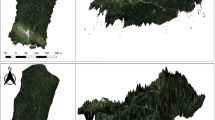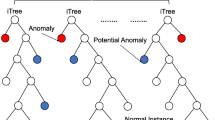Abstract
In the last decade, airborne light detection and ranging (LiDAR) scanning (ALS) technology has become a powerful technique for remote sensing, imaging, and mapping. However, the data obtained from any measurement system can include inaccurate signals affected by systematic errors or by the external environment. De-noising to remove inaccurate outlier points is a fundamental and challenging problem for ALS-based mapping applications. The proposed method aims to recover the patterned (planar and linear) points within the assigned outlier and removed points. The method consists of 3 steps. First, statistical outlier removal (SOR) filtering is implemented, and outlier points are detected with the filtering method. Next, the machine learning system reclassifies the filtered outlier points. If the classification result is “inlier” , that point is added to the filtered inlier point cloud as an inlier point. The accuracy of outlier points was evaluated against a manually determined validation set. The results achieved \(99\%\) and \(98\%\) according to the highest overall accuracy criterion and kappa coefficient, respectively. These findings are a promising step to test the proposed method in three different test areas and extend it to widespread spatial dimensions. Furthermore, the findings show that many useful points are removed by SOR filtering. The developed methodology contributes to the reduction of errors caused by data losses in various modelling studies, especially for power transmission line and 3D façade modelling studies.











Similar content being viewed by others
References
Ada, M., & San, B. T. (2018). Comparison of machine-learning techniques for landslide susceptibility mapping using two-level random sampling (2lrs) in alakir catchment area, antalya, turkey. Natural Hazards, 90(1), 237–263.
Akar, Ö., & Güngör, O. (2015). Integrating multiple texture methods and ndvi to the random forest classification algorithm to detect tea and hazelnut plantation areas in northeast turkey. International Journal of Remote Sensing, 36(2), 442–464.
Anashkin, I., Mukhamadieva, F., Kondakov, A., & Migranov, V. (2018). Determination of the volume of a tank from the results of laser scanning. Measurement Techniques, 61(7), 670–674.
Ben-Gal, I. (2005). Outlier detection. In Data mining and knowledge discovery handbook (pp. 131–146). Springer.
Blomley, R., Weinmann, M., Leitloff, J., & Jutzi, B. (2014). Shape distribution features for point cloud analysis-a geometric histogram approach on multiple scales. ISPRS Annals of the Photogrammetry, Remote Sensing and Spatial Information Sciences, 2(3), 9.
Breunig, M. M., Kriegel, H. P., Ng, R. T., & Sander, J. (2000). LOF: identifying density-based local outliers. ACM Sigmod Record, ACM, 29, 93–104.
Camgöz, N. C., Kindiroglu, A. A., & Akarun, L. (2014). Gesture recognition using template based random forest classifiers. In European conference on computer vision (pp. 579–594). Springer.
Charron, N., Phillips, S., & Waslander, S. L. (2018). De-noising of lidar point clouds corrupted by snowfall. In Proceedings: 2018 15th Conference on Computer and Robot Vision, CRV 2018 (pp. 254–261). https://doi.org/10.1109/CRV.2018.00043.
Charu, C. A. (2019). Outlier analysis. Springer. https://doi.org/10.1007/978-1-4614-6396-2.
Chauhan, I., Brenner, C., Garg, R. D., & Parida, M. (2014). A new approach to 3d dense lidar data classification in urban environment. Journal of the Indian Society of Remote Sensing, 42(3), 673–678. https://doi.org/10.1007/s12524-013-0354-4.
Chehata, N., Guo, L., & Mallet, C. (2009). Airbone LiDAR feature selection for urban classification using random forest. International Society for Photogrammetry and Remote Sensing (ISPRS), 38(c), 207–212.
Chen, C., Li, Y., Zhao, N., & Yan, C. (2018). Robust interpolation of dems from lidar-derived elevation data. IEEE Transactions on Geoscience and Remote Sensing, 56(2), 1059–1068.
Cheng, S. W., & Lau, M. K. (2017). Denoising a point cloud for surface reconstruction. Preprint arXiv:170404038.
Cohen, J. (1960). A coefficient of agreement for nominal scales. Educational and Psychological Measurement, 20(1), 37–46.
Erbaş, M. (2016). Lidar verilerinden enerji nakil hatlarının otomatik tespit edilmesi Çalıışmaları. Harita Dergisi, 156, 32–40.
Girardeau-Montaut, D. (2019). Cloudcompare-open source project. OpenSource Project.
Guennebaud, G., Jacob, B., et al. (2010). Eigen v3. http://eigen.tuxfamily.org
Karatzoglou, A., Smola, A., Hornik, K., & Zeileis, A. (2004). kernlab: An S4 package for kernel methods in R. Journal of Statistical Software, 11(9), 1–20.
Kavzoglu, T., & Colkesen, I. (2009). A kernel functions analysis for support vector machines for land cover classification. International Journal of Applied Earth Observation and Geoinformation, 11(5), 352–359. https://doi.org/10.1016/j.jag.2009.06.002.
Kayi, A., Erdoğan, M., & Eker, O. (2015). Optech ha-500 ve riegl lms-q1560 ile gerçekleştirilen lidar test sonuçları. Harita dergisi, 153, 42–46.
Khaloo, A., & Lattanzi, D. (2017). Robust outlier detection and normal estimation in noisy infrastructure 3D point clouds. Computing in Civil Engineering 2017: Sensing, Simulation, and Visualization (pp. 323–331).
Kirasich, K., & Smith, T. (2018). Random Forest vs Logistic Regression: Binary Classification for Heterogeneous Datasets. SMU Data Science Review, 1(3), https://scholar.smu.edu/datasciencereview/vol1/iss3/9
Knorr, E. M., Ng, R. T., & Tucakov, V. (2000). Distance-based outliers: Algorithms and applications. The VLDB Journal-The International Journal on Very Large Data Bases, 8(3–4), 237–253.
Kuhn, M., Wing, J., Weston, S., Williams, A., Keefer, C., Engelhardt, A., Cooper, T., Mayer, Z., Kenkel, B., the R Core Team, Benesty, M., Lescarbeau, R., Ziem, A., Scrucca, L., Tang, Y., Candan, C., & Hunt, T. (2019). caret: Classification and Regression Training. https://CRAN.R-project.org/package=caret, r package version 6.0-84.
Lantz, B. (2013). Machine Learning With R. https://doi.org/10.1017/CBO9781107415324.004, arXiv:1011.1669v3
Lesmeister, C. (2015). Mastering machine learning with R. Packt Publishing Ltd.
Li, H., Liu, Y., Xiong, S., & Wang, L. (2015). Pedestrian detection algorithm based on video sequences and laser point cloud. Frontiers of Computer Science, 9(3), 402–414. https://doi.org/10.1007/s11704-014-3413-2.
Li, X. G., Zhang, Y. P., & Yang, Y. W. (2017). Outlier detection for reconstructed point clouds based on image. In Proceedings First International Conference on Electronics Instrumentation & Information Systems (Eiis 2017) (pp. 899–904).
Liaw, A., & Wiener, M. (2002). Classification and regression by randomforest. R News, 2(3), 18–22.
Lu, Y. Y., Stamatopoulos, C., & Fraser, C. S. (2013). Evaluation of outlier detection based on support vector machine regression for close-range photogrammetry. Videometrics, Range Imaging, and Applications XII; and Automated Visual Inspection, 8791, 879109. https://doi.org/10.1117/12.2021512.
Lucas, C., Bouten, W., Koma, Z., Kissling, W. D., & Seijmonsbergen, A. C. (2019). Identification of linear vegetation elements in a rural landscape using lidar point clouds. Remote Sensing, 11(3), 292.
Manning, C. D., Raghavan, P., & Schutze, H. (2008). Introduction to information retrieval. Cambridge University Press.
Melis, U., Tunalıoğlu, N., Arıcan, D., & Arda, T. (2019). Yersel lazer tarama verisi ile elde edilen 3b modellerde filtreleme etkisinin araştırılması. Gazi Üniversitesi Mühendislik-Mimarlık Fakültesi Dergisi, 34(4).
Meyer, D., Dimitriadou, E., Hornik, K., Weingessel, A., & Leisch, F. (2019). e1071: Misc Functions of the Department of Statistics, Probability Theory Group (Formerly: E1071), TU Wien. https://CRAN.R-project.org/package=e1071, r package version 1.7-1.
Najdataei, H., Nikolakopoulos, Y., Gulisano, V., & Papatriantafilou, M. (2017). Lisco: A continuous approach in lidar point-cloud clustering. Preprint arXiv:171101853
Ning, X., Li, F., Tian, G., & Wang, Y. (2018). An efficient outlier removal method for scattered point cloud data. PLoS ONE, 13(8), 1–22. https://doi.org/10.1371/journal.pone.0201280.
Nurunnabi, A., West, G., & Belton, D. (2015). Outlier detection and robust normal-curvature estimation in mobile laser scanning 3d point cloud data. Pattern Recognition, 48(4), 1404–1419.
Nurunnabi, A., Sadahiro, Y., & Laefer, D. F. (2018). Robust statistical approaches for circle fitting in laser scanning three-dimensional point cloud data. Pattern Recognition, 81, 417–431. https://doi.org/10.1016/J.PATCOG.2018.04.010.
PDAL contributors (2018) PDAL Point Data Abstraction Library. https://pdal.io
Polat, N., & Uysal, M. (2018). An experimental analysis of digital elevation models generated with lidar data and uav photogrammetry. Journal of the Indian Society of Remote Sensing, 46(7), 1135–1142. https://doi.org/10.1007/s12524-018-0760-8.
R Core Team (2019) R: A Language and Environment for Statistical Computing. R Foundation for Statistical Computing, Vienna, Austria, https://www.R-project.org/
Rakotosaona, M. J., La Barbera, V., Guerrero, P., Mitra, N. J., & Ovsjanikov, M. (2019). POINTCLEANNET: Learning to Denoise and Remove Outliers from Dense Point Clouds. Preprint arXiv:190101060 xx:1–16.
Rusu, R. B. (2009). Semantic 3d object maps for everyday manipulation in human living environments. PhD thesis, Computer Science department, Technische Universitaet Muenchen, Germany.
Rusu, R. B., & Cousins, S. (2011). Point cloud library (pcl). In 2011 IEEE International Conference on Robotics and Automation (pp. 1–4).
Rusu, R. B., Marton, Z. C., Blodow, N., Dolha, M., & Beetz, M. (2008). Towards 3d point cloud based object maps for household environments. Robotics and Autonomous Systems, 56(11), 927–941.
Sotoodeh, S. (2006). Outlier detection in laser scanner point clouds. International Archives of Photogrammetry, Remote Sensing and Spatial Information Sciences, 36(5), 297–302.
Stucker, C., Richard, A., Wegner, J. D., & Schindler, K. (2018). Supervised outlier detection in large-scale MVS point clouds for 3D city modeling applications. ISPRS Annals of the Photogrammetry, Remote Sensing and Spatial Information Sciences, 4(2), 263–270. https://doi.org/10.5194/isprs-annals-IV-2-263-2018.
Tian, X., Xu, L., Li, X., Jing, L., & Zhao, Y. (2012). A kernel-density-estimation-based outlier detection for airborne lidar point clouds. In 2012 IEEE International Conference on Imaging Systems and Techniques Proceedings (pp. 263–266). IEEE.
Unal, Y., Polat, K., Kocer, H. E., & Hariharan, M. (2015). Detection of abnormalities in lumbar discs from clinical lumbar mri with hybrid models. Applied Soft Computing, 33, 65–76.
Ustuner, M., Balik Sanli, F., Dixon, B., Sanli, F. B., & Dixon, B. (2015). Application of support vector machines for landuse classification using high-resolution rapideye images: A sensitivity analysis. European Journal of Remote Sensing, 48(1), 403–422. https://doi.org/10.5721/EuJRS20154823.
Xian, Y., Xiao, J., & Wang, Y. (2019). A fast registration algorithm of rock point cloud based on spherical projection and feature extraction. Frontiers of Computer Science, 13(1), 170–182. https://doi.org/10.1007/s11704-016-6191-1.
Xiao, J., Liu, S., Hu, L., & Wang, Y. (2018). Filtering method of rock points based on BP neural network and principal component analysis. Frontiers of Computer Science, 12(6), 1149–1159. https://doi.org/10.1007/s11704-016-6170-6.
Yurtseven, H., Çoban, S., Akgül, M., & Akay, A. O. (2019). Individual tree measurements in a planted woodland with terrestrial laser scanner. Turkish Journal of Agriculture and Forestry, 43(2), 192–208.
Zeybek, M. (2018). Estimation of powerline route from airborne lidar. In International Conference on Engineering Technologies, Konya, Turkey (pp. 293–297).
Zeybek, M. (2021). Classification of uav point clouds by random forest machine learning algorithm. Turkish Journal of Engineering, 5, 51–61. https://doi.org/10.31127/tuje.669566.
Zeybek, M., Sanlioglu, I., & Genc, A. (2015). Yüksek çözünürlüklü yersel lazer tarama verilerinin filtrelenmesi ve filtrelemelerin heyelan izlemeye etkisi. Dogal Afetler ve Cevre Dergisi, 1, 11–20. https://doi.org/10.21324/dacd.22635.
Acknowledgements
The author would like to thank Hasan Başak for English editing of the manuscript. I would like to thank the General Directorate of Turkey Mapping for sharing the Bergama Airborne-LiDAR test data used in this study.
Author information
Authors and Affiliations
Corresponding author
Additional information
Publisher's Note
Springer Nature remains neutral with regard to jurisdictional claims in published maps and institutional affiliations.
About this article
Cite this article
Zeybek, M. Inlier Point Preservation in Outlier Points Removed from the ALS Point Cloud. J Indian Soc Remote Sens 49, 2347–2363 (2021). https://doi.org/10.1007/s12524-021-01397-4
Received:
Accepted:
Published:
Issue Date:
DOI: https://doi.org/10.1007/s12524-021-01397-4




